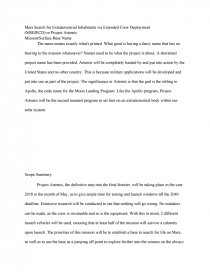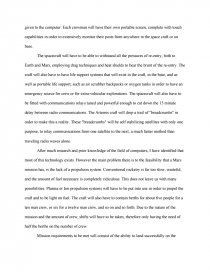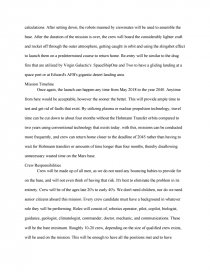Mars Search for Extraterrestrial Inhabitants Via Extended Crew Deployment
Essay by Nicolas • May 17, 2012 • Research Paper • 2,616 Words (11 Pages) • 1,659 Views
Essay Preview: Mars Search for Extraterrestrial Inhabitants Via Extended Crew Deployment
Mars Search for Extraterrestrial Inhabitants via Extended Crew Deployment
(MSEIECD) or Project Artemis
Mission/Surface Base Name
The name means exactly what's printed. What good is having a fancy name that has no bearing to the mission whatsoever? Names need to be what the project is about. A shortened project name has been provided. Artemis will be completely funded by and put into action by the United States and no other country. This is because military applications will be developed and put into use as part of the project. The significance or Artemis is that the god is the sibling to Apollo, the code name for the Moon Landing Program. Like the Apollo program, Project Artemis will be the second manned program to set foot on an extraterrestrial body within our solar system.
Scope Summary
Project Artemis, the definitive step into the final frontier, will be taking place in the year 2018 in the month of May, as to give ample time for testing and launch windows till the 2040 deadline. Extensive research will be conducted to see that nothing will go wrong. No mistakes can be made, as the crew is invaluable and so is the equipment. With this in mind, 2 different launch vehicles will be used, ensuring that at least half of the mission will survive a calamity upon launch. The priorities of this mission will be to establish a base to search for life on Mars, as well as to use the base as a jumping off point to explore further into the cosmos on the always expanding search for life. The government as well as the military of the United States will be the primary and only users of Project Artemis. The best landing site would have to be the lava tubes that already worm their way through the planet.
These pictures, already taken by the Mars Reconnaissance Orbiter and the site which on an equivalent Earth location, has already collected samples of ice and microbes of many species, which would deem it a suitable exploration site and a shelter worthy site from radiation as well as dust storms and other various calamities.
Project Artemis ConOps
Mission Statement
Project Artemis will be known as the final word on the mission to Mars. This is it, there is no turning back. The mission will be a full on exploration of Mars and the first permanent base on another planet. From Artemis, other bases will spring up, and eventually colonization will occur, along with the possibility of terraforming the planet to make it habitable by future generations without use of artificial technologies.
Mission/System Requirements/Elements
In order for this mission to be feasible, extensive research consisting of test flights, Mars landers, probes, and other devices will need to be used to preplan and map out the landing, base, and collect data in atmosphere in order to provide data and figures to be able to tune the computers that will be mostly operating and guiding the mission. Computers on board will need to be light enough to not adversely affect the performance of the craft, and will also need to be able to handle duties of operations spacecraft based equipment, such as communications relays, life support systems, air scrubbers, guidance, re-entry flight paths, and controlled burns for course re-adjustments. Technology for this already exists, as computers are becoming more advanced exponentially throughout the years. Portable displays and multitasking abilities will be given to the computer. Each crewman will have their own portable screen, complete with touch capabilities in order to extensively monitor their posts from anywhere in the space craft or on base.
The spacecraft will have to be able to withstand all the pressures of re-entry, both to Earth and Mars, employing drag techniques and heat shields to bear the brunt of the re-entry. The craft will also have to have life support systems that will exist in the craft, in the base, and as well as portable life support, such as air scrubber backpacks or oxygen tanks in order to have an emergency source for crew or for extra-vehicular explorations. The spacecraft will also have to be fitted with communications relays tuned and powerful enough to cut down the 15 minute delay between radio communications. The Artemis craft will drop a trail of "breadcrumbs" in order to make this a reality. These "breadcrumbs" will be self stabilizing satellites with only one purpose, to relay communications from one satellite to the next; a much faster method than traveling radio waves alone.
After much research and prior knowledge of the field of computers, I have identified that most of this technology exists. However the main problem there is to the feasibility that a Mars mission has, is the lack of a propulsion system. Conventional rocketry is far too slow, wasteful, and the amount of fuel necessary is completely ridiculous. This does not leave us with many possibilities. Plasma or Ion propulsion systems will have to be put into use in order to propel the craft and to be light on fuel. The craft will also have to contain berths for about five people for a ten man crew, or six for a twelve man crew, and so on and so forth. Due to the nature of the mission and the amount of crew, shifts will have to be taken, therefore only having the need of half the berths on the number of crew.
Mission requirements to be met will consist of the ability to land successfully on the surface of Mars, no injury to crew, retrieval of scientific data, experiments carried out, and to establish the first operational and self sustaining Mars base. With these requirements in mind, the base must be easily constructible and habitable by a limited amount of crew, therefore requiring the use of robots to aid in heavy lifting outside of the original vehicle. Robots will have to have internal power sources along with the ability to be remotely operated and provided with live video feeds to be operated beyond line of sight of the crew when assembling the base itself.
Outpost Location
With all these spacecraft components taken care of, the real work needs to be turned towards the base and its location. The base shall be located in the lava tubes found throughout the planet. Upon further research and examination by rovers, a specific site shall be named and used. Lava tubes will be utilized for their protection from radiation, low amounts of material needed to make a contained environment, because of the need to only seal the holes rather than make an entire building or structure. As well
...
...








